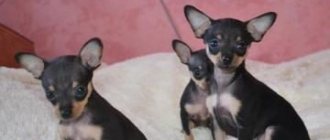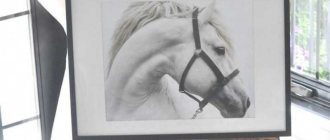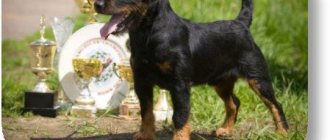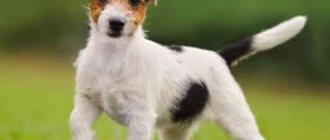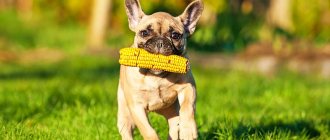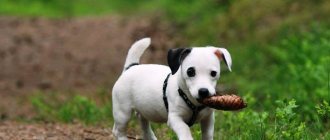The history of the emergence of such a breed as the Toy Terrier goes back to old England, where it was created and formed for the purpose of exterminating small burrowing pests such as mice and rats. These rodents were the main cause of epidemics, as they served as carriers of various infections.
But over time, when people learned to fight diseases on their own, the help of little hunters ceased to be necessary. It seemed that the breed was doomed to extinction, but fashion gave it a second life.
English toys appeared much earlier than Russian ones. If the history of English takes its origins from the 17th century, then the latter were introduced only from the middle of the past. Toy terriers very quickly won the hearts of people, especially the fair half of the population and children.
Appearance
The Russian Toy Terrier is an elegant dog with long straight legs and lean muscles. His neck is elongated and elegant. The tip of the nose, depending on the color of the toy, is brown or black. The ears of such dogs are erect, thin, set high and have the shape of an isosceles triangle with pointed or rounded tips.
Among Russian Toy Terriers there are two variations: smooth-haired and long-haired. The first have: the coat is shiny and short, close to the body, there is no undercoat or bald patches; in the second, the coat is moderately long (3–5 cm), can be somewhat wavy or straight, frames the body without hiding its contours.
The color is usually uneven: on the face, chest and limbs there are spots lighter than the main tone. The color of the coat, as well as its shades, is variable: from fawn to black. The color is rich.
Gender is weakly expressed outwardly, however, it is clearly manifested in the behavioral line.
Water
There should be a bowl of water next to the food bowl. Even if there is no food, water should always be in the bowl.
Water for a dog should be:
- fresh (change 2 times a day);
- clean;
- drinking.
There is no need to boil water.
You need to monitor your puppy's drinking habits. Low water consumption, as well as increased thirst, may indicate pathology.
Important! At the slightest deviation in one direction or another, you should seek advice from a specialist.
Character
Dogs of this breed are surprisingly dynamic and playful. They are friendly and get along well with others, including other pets. They are especially loving towards their owners and are also extremely loyal to them.
The psyche of Russian toy terriers is labile - they are very emotional dogs that “take everything to heart.” There is a danger of stress. In this regard, the animal should not be scolded, left alone, and it is advisable to exclude loud sounds that may frighten it.
Toy terriers are excellent for home keeping. For kids, the dog will be an ideal play companion; will give elderly and lonely people all the overwhelming affection and warmth, brightening up the gray days.
What should you buy?
Before purchasing a toy terrier, it is advisable to take care of the following items:
- A special enclosure or playpen structure.
- House, bedding.
- Bowls for food and water.
- Rubber toys.
- Toilet tray.
- Filler.
- Claw clipper.
Caring for the Russian Toy
Dogs of this breed are unpretentious in maintenance. These are not the big dogs that need to be walked several times a day. The toy is great at learning to go to a regular cat litter box when needed. However, walking cannot be completely ruled out. A small terrier needs periodic outings into nature and fresh air for its psychophysical health.
This dog does not require frequent bathing, only once a month. During water procedures, it is worth inserting cotton wool into your ears to prevent water from flowing into them. In addition, your ears should be checked for infections from time to time. Also, as necessary, the toy's claws are trimmed.
Caring for the coat of the long-haired variety comes down to daily combing with a fine-toothed comb - a pleasant procedure for both the pet and its owner. Although a terrier is considered a tame dog, you shouldn’t carry it in your arms or in a bag all the time, it needs a burst of bursting energy.
At what age do toy terriers have their tail docked?
According to dog experts, the ideal time for tail docking is at birth . A newborn baby experiences virtually no pain, and the procedure is easier for him.
If the tail was not docked during this period of time or in the next week, then it is better to seek help from a veterinarian or call him at home.
To be more precise about the age at which such an operation is performed, dog breeders agree that if the puppies are born healthy and strong, this procedure can already be carried out by 3-4 days . If the animal will not participate in exhibitions, then it is permissible not to carry out this operation at all.
Feeding
Despite the fact that the Russian Toy Terrier is a miniature dog and does not need large portions of food, its diet must still contain all the necessary nutrients and minerals.
Adult dogs
Feeding rules:
- main meals: twice a day - in the morning and after an evening walk;
- It is allowed to pamper your pet with a treat in the middle of the day (dog biscuit, leather bone);
- calculation of the daily diet: 50–80 grams of food per 1 kg of animal weight;
- when calculating daily feeding, the dog’s lifestyle is taken into account: older and inactive people require less food than young and active people or pregnant women;
- food should be at room temperature;
- The water is certainly raw, but filtered.
Daily diet:
- meat: lamb, veal, raw beef;
- poultry: boiled turkey and chicken (boneless);
- sea fish - boiled fillet;
- porridge: oatmeal, buckwheat, rice (with water);
- fermented milk products: low-fat cottage cheese, kefir, fermented baked milk;
- vegetables (carrots are required) - fresh (grated on a fine grater), stewed, boiled (without salt);
- fruits: bananas and apples are especially useful.
Weekly (no more than once):
Boiled eggs;
- offal: heart, kidneys, liver;
- corn porridge.
Contraindicated products:
- milk;
- sausage (any);
- smoked products;
- pork;
- nuts;
- legumes;
- sweets;
- bell pepper
If you prefer to feed your pet dry food, you will find the necessary instructions for this on the package. There is no universal guide for dry food, since different manufacturers have different compositions of nutrients included in them.
High-end ready-made food is produced by: Hills, Royal Canin, Orijen, Canidae, Eagle Pack. Please note that these companies produce food specifically for small dogs, some even by breed, as indicated on the packaging.
Puppies
Naturally, from the moment they are born, babies are fed exclusively with mother's milk. After three weeks, without removing the mother from the breast, small complementary foods are introduced. Additional food in the form of beef and low-fat cottage cheese is given in small peas - always warmed to room temperature - 3 times a day.
Menu from 6 to 8 weeks (feeding every 4 hours):
- 1 feeding: a ball of raw meat;
- 2 feeding: cottage cheese diluted with milk or kefir;
- 3 feeding: cottage cheese again;
- 4 feeding: porridge boiled in water - rice, oatmeal or buckwheat;
- 5 feeding: milk porridge;
- 6 feeding: a pea of raw meat.
It is best for puppies to eat meat from the menu listed above, however, you should not exceed the recommended daily portion. There is a significant risk that she will continue to prefer only meat. Ignoring other foods will have a bad effect on his health and overall well-being.
The diet from two to five months remains the same, supplemented with vegetables and fruits. Meals are reduced to four times a day.
From five months, the feeding schedule is adjusted to three meals a day, and after nine months - to two meals a day, with the transition to the diet of adults.
It is extremely important to ensure that the baby receives the food it needs in full. Otherwise, this is fraught with improper development of the musculoskeletal system. This can be tracked quite simply: the puppy must be periodically felt - the ribs should not be noticeable, but they should be felt. If you deviate from this condition, you need to adjust the power supply, depending on which direction the slope goes.
Vaccination
You need to vaccinate your puppy in 2 stages. The first vaccination is given at 3 weeks, and the second at 2-2.5 months. One vaccination will not protect your pet from dangerous diseases; this is a preparatory stage for the second vaccination. Before vaccination, the baby must be dewormed.
When the second vaccination is given, all precautions must be taken: prevent the animal from coming into contact with street dirt and other dirty places - the hallway.
Buying a puppy with only one vaccination is equivalent to buying a puppy with no vaccinations at all!
To know the correct duration of vaccinations and the interval between them, you can rely on the puppy vaccination table:
- 3 weeks - vaccination against parainfluenza and borderellosis;
- 4 weeks - enteritis and plague;
- 8-10 weeks - repeated vaccination against distemper and enteritis, against leptospirosis and viral hepatitis;
- 11-13 weeks - previous vaccines repeated + rabies;
- Once a year, do the previous vaccination procedures.
Upbringing
Despite their diminutive size, they are still terriers, and they have a rather serious character with a bright temperament. Toys are perfectly trainable and if aggression is noticed in a puppy, it should be sent for re-education. This will help avoid problems with aggression in the future. However, “characteristic” toys are a rarity; most of them are cute and cheerful dogs.
It is important to remember that a “lap” dog is not a cat that walks on its own, nor is it a toy. She has her own needs, characteristics and instincts. If this is neglected, then the risk of developing “small dog syndrome” or “Napoleon complex” increases in the toy terrier. At the same time, the dog will become uncontrollable: he will consider himself the main one in the house, bark at everything that does not suit him, and rush at others.
To avoid excessive self-will, you must strictly follow a number of rules:
- do not allow him to aggressively jump on people;
- do not allow barking and growling whenever you want;
- make sure that the dog does not climb onto your lap on its own;
- prohibit sleeping on the owner's pillow.
Ready-made feed
Those specialists who have dealt with laboratory tests of feed can authoritatively state that the content of substances in feed does not correspond to what is written on the label. Unfortunately, manufacturers are well aware of how dry food testing works. Since it is not always possible to measure the quantitative composition of the substances stated in the recipe.
Both “simple” manufacturers and well-promoted product brands are guilty of inconsistency in composition. Very often, feed does not contain the required amount of vitamins and microelements, and expensive natural proteins are replaced with artificial amino acids.
High temperatures during production “kill” even heat-stable vitamins. Consequently, such food cannot fully provide the body with everything it needs.
When choosing food, you cannot rely on someone else’s opinion and experience. The food may be suitable for one dog, but cause pathology for another.
In any case, when deciding to feed dry food, you should give preference to:
- professional;
- designed for small breeds;
- labeled (indicating the composition, standard, date of production, address of the manufacturer).
Advantages
Without a doubt, feeding ready-made food is easy. If decent food is found and the puppy is cheerful, energetic, has good growth, and has no problems with the skin and mucous membranes, then it can be used.
Disadvantages of ready-made feeds
The disadvantages can be listed as follows:
- uncertainty of composition;
- imbalance of components;
- even expensive food contains preservatives and emulsifiers, which can cause pathology in the body;
- frequent replacement of natural ingredients with artificial additives.
Changing baby teeth
The Russian Toy Terrier, despite its miniature size, has the same set of teeth as the Caucasian Shepherd Dog - 42 pieces. Of these, 22 are located on the lower jaw and 20 on the upper jaw. They include 4 types of teeth: incisors, canines, molars and premolars.
Although it is important for toy terriers intended for exhibitions to have all their teeth, they are not disqualified due to the absence of molars. In addition, such dogs are allowed for mating.
Toys are born with absolutely no teeth. The first primary canines erupt on days 12–16 of life. Then, on each jaw another 6 premolars and 6 incisors are shown. The number of primary premolars is exactly this due to the fact that at this age the first tooth is still missing. By two months, approximately 28 baby teeth have formed in the toy's mouth.
The replacement of baby teeth with molars begins at the age of four months or six months and continues until eight months. The incisors are replaced first. Under the roots of the deciduous teeth, the rudiments of the molar incisors are born, during which the roots of the first ones dissolve and become shaky. Then the baby teeth fall out on their own.
In show Russian Toy Terriers, by the age of eight months, absolutely all their teeth should have changed. If this does not happen, you should be wary. Due to the fact that the molars grow along the same canals as the milk teeth, failure of the latter to fall out may result in a lack of growth or curvature of the former.
During the period when puppies are changing their teeth, you need to carefully monitor their health. In weakened dogs, this process may be delayed or extended over time. Make sure you have enough vitamins and protection from hypothermia.
If a baby tooth does not fall out on time, you can try to help the baby on your own. To do this, gently shake the tooth that is about to fall out. The degree of unsteadiness will increase and eventually it will fall out. If you can’t cope on your own, you need to take the puppy to a veterinary clinic. There he will be helped in this matter with the use of anesthesia or anesthesia.
Vitamins and supplements
With a natural diet, a toy terrier puppy needs vitamins and supplements. Sources of useful substances can be natural, pharmacy (publicly available) and industrial.
Natural vitamin supplements for a toy terrier puppy:
- Meat and bone meal.
- Clean, dried, crushed egg shells.
- Bran.
- Fish, chicken, beef liver.
- Greens, vegetables, fruits.
- Sunflower oil, olive oil.
- Gelatin.
- Brewer's yeast.
Pharmacy vitamin supplements for a toy terrier puppy:
- Fish fat.
- Feed tricalcium phosphate.
- Omega-3, Omega-6.
- B vitamins.
- Undevit and analogues.
Industrial vitamin complexes are sold in pet stores and veterinary pharmacies. To prevent injury to the oral cavity, it is better for a toy terrier puppy to purchase vitamins in the form of a paste or powder that is added to food.
Health
With high-quality maintenance of Russian Toys, they practically do not get sick.
It is important to ensure that the dog does not fall. In particular, you should not take risks by lifting it onto objects whose surface is higher than 40 cm from the floor. It is also necessary to control the toy's contacts with large dogs. In both cases, the injury may be caused by the inability of terrier dogs to balance their size and strength with their desires. These dogs simply do not feel their small size (especially cables).
When a dog comes into contact with a very small child, it is necessary to closely monitor their games. A baby who does not yet know how to coordinate his movements and control strength can accidentally cause serious injury to the dog.
Do not buy a Russian Toy Terrier puppy on the market, there is a high probability that the dog will be nervous and sickly. To be absolutely sure of your dog’s psychophysical health, contact only trusted breeders.
Organs most susceptible to diseases:
- teeth;
- skeletal system;
- skin covering;
- pancreas;
- heart muscle.
Breed Features
Toy Terriers are small but very energetic. A small portion of food should provide your pet with:
- proteins (proteins);
- fats;
- carbohydrates;
- vitamins;
- minerals.
When composing a diet, it should be taken into account that the stomach of an adult dog can optimally accommodate the volume of one tablespoon. A puppy's is much smaller. Of course, the stomach is a muscular organ that can stretch and increase several times, but is this good?
Important! When feeding a puppy, overeating should not be allowed. A low content of energy substances per serving will be accompanied by a constant search for food and an increase in the volume of food eaten. Excessively high-calorie feeding is also unacceptable.
The most energy-rich fats and carbohydrates, especially fast ones (sugars). For a carnivore, especially small breed dogs, there is no need for large quantities of such components.
Bitch after giving birth
If the bitch is unable to care for the puppies in the first few days (for example, after a caesarean section), you will have to imitate the actions of the dog by massaging the puppies' bellies with a warm, slightly damp cloth. A mother bitch coming off anesthesia, especially if she is a first-time mother, may be somewhat shocked by the appearance of puppies underneath her, and may become quite nervous when the small newborn puppies begin to crawl over her extremely painful belly. Therefore, when the bitch finally comes to her senses, return the puppies to her one at a time and observe her reaction before introducing the remaining puppies to her.
If she has had a litter before, she will most likely take them under her and will look after them normally even despite the stitch on her belly. However, a bitch who has become a mother for the first time will behave a little more warily, so sit next to her at all times. It will be good if you have an assistant to make your task easier. The point is that if the mother is restless, she needs your constant presence for several days and nights.
You can walk away for a minute and return to find that the bitch, for example, has licked and chewed off part of the umbilical cord along with the peritoneum, or has calmly chewed off the heads or limbs of her puppies. This is rather a rare and atypical behavior for a mother bitch, but you need to know about it and be prepared for it. You can also keep the puppies in the first 24 hours after a caesarean section in a box with a heating pad next to the bitch and place the puppies only for feeding. If the dog shows no interest in puppies at all, it may be sick. Call a doctor without delay.
Natural nutrition
- Balance your dog’s diet in terms of proteins, fiber, vitamins and minerals - this is the main difficulty of eating “natural” food.
- Refrain from feeding your toy from your table; teach her proper manners as a puppy.
- Small dogs easily gain excess weight. Do not overfeed the dog (no more than 50-80 g/kg), take an active walk with it, thirty minutes after eating.
- Cook separately for your pet only from approved foods.
Here is an example of natural nutrition.
How does it develop day by day in the first month?
| Days | Physical development and behavior change |
| 1-4 | The puppy cannot see or hear, he has no fat layer, and thermoregulation is undeveloped. During this period, the puppy produces meconium (original feces). |
| 5 | Pain sensitivity is reduced, the brain is poorly developed. |
| 6-8 | The nose becomes stained, reflexive chills appear, and active weight gain occurs. |
| 8-9 | The original weight is doubled. |
| 10-15 | The puppy's eyes begin to open, the pupil reacts to light, but the retina is poorly developed. |
| 16-18 | A fat layer begins to form, thermoregulation improves, and the puppy gradually learns to cope without additional sources of heating. |
| 19-21 | The toy terrier baby begins to hear and reacts to sound. |
| 22 | Baby teeth begin to emerge. |
| 23-24 | The sucking reflex fades, interest in solid food appears. The puppy already knows how to bite, chew, and is actively exploring the world. |
| 25-30 | Thermoregulation is fully formed, the body temperature is like that of an adult, the baby is already responding to its name, and motor activity is increasing. |
How to choose a puppy?
If you decide to buy a toy terrier puppy, then you should pay attention to its behavior.
NOTE!
A healthy puppy is active, mobile, eats well, is interested in its surroundings, is inquisitive and cheerful.
The second important factor is an excellent appetite; a healthy puppy always eats well, licks the bowl and will not miss any tasty morsel.
A healthy pet should not have any discharge from the ears, nose, anus or genitals . Before purchasing, carefully examine the baby to make sure everything is okay with him.
Pay attention to the conditions in which the puppies are kept. The place should be clean, spacious and free of drafts. A tray or diaper is required.
If the puppy shakes its head or scratches its ears. This may indicate the presence of parasites.
Touch the puppy's ear; it shouldn't be hot and red..
Pay attention to your joints; healthy joints are always strong and flexible. A healthy dog moves forward easily and cheerfully, and in no case limps.
Prohibited Products
There are foods that are not acceptable as dog food:
- fatty pork;
- raw chicken;
- smoked meats and sausages;
- freshwater and any raw fish;
- ready-made sauces (mayonnaise);
- fried foods (cutlets, etc.);
- pasta and flour products.
Taking into account all the nuances and characteristics of the breed, you can easily create a feeding diet and provide the puppy’s body with the necessary nutrients.
Walks
As soon as your baby starts taking street walks with you, you should also take care of the equipment: collar, leash (or harness) and clothes. The delicate skin of toys, completely devoid of undercoat, is vulnerable to both cold and sunlight.
best to start socializing your toy by introducing him to the neighbors’ dogs from a young age .
Important! Mandatory after you have completed the second course of vaccinations.
